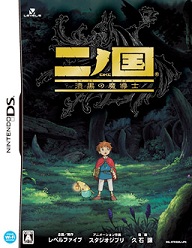Atelier Iris 2: The Azoth of Destiny
PlayStation 2
Reviewed: 04/07/2006
 Back in June 2005, NIS America brought over the latest installment in Gust’s ongoing Atelier series, entitled Atelier Iris: Eternal Mana, and has now seen fit to increase the love with its prequel, Atelier Iris 2: The Azoth of Destiny.
Back in June 2005, NIS America brought over the latest installment in Gust’s ongoing Atelier series, entitled Atelier Iris: Eternal Mana, and has now seen fit to increase the love with its prequel, Atelier Iris 2: The Azoth of Destiny.
As with nigh-every RPG ever made, the story starts out peacefully enough. Viese, one of the two main characters, is about to enter into a pact with the wood mana, Dour, thereby making her into a full-fledged alchemist. Accompanying her is the other main character, and the one which the story mostly follows, Felt. Upon their return from Dour’s tree, disaster strikes suddenly as an earthquake sucks up all the mana Holy Grounds in Eden. Shortly after this occurs, Felt manages to free the decidedly Excalibur-like Azure Azoth from its stone resting place. After doing so, the sword tells Felt (yes, it can talk) that he must travel to the world of Belkhyde to restore Eden once again to its former peacefulness.
| Big swords for big bosses. |
Gameplay has gotten a bit of a facelift from its predecessor, the battle system being the most marked change. MP has been done away with, instead being replaced by a skill points system, wherein skill points are accumulated through battle, and any character can use them to perform special techniques. This is accomplished by one of the two basic attacks, the charge attack. The other, Break Attacks, serve to delay your enemy’s turn, which is indicated by an unnamed meter which I like to call the “initiative bar,” up in the corner. These new additions create a much-appreciated element of strategy for combat, instead of the simple “attack, heal, repeat” cycle that appears in so many RPGs nowadays.
In addition to combat, item crafting has also been somewhat revamped. To craft a new item, one must find a recipe for it in the world. Mana items are the main “utility” items of the game, performing tasks such as healing, dealing damage, and buffing the party. Your typical accessories can also be crafted as well. Alchemy items can also be equipped and, while not affecting stats really at all, are valuable in that they enable a character to learn skills from them. These skills are passive, and once learned, are permanent. Weapons, while not exactly crafted, can be upgraded to increase their power and to enable the use of new attacks, which can also be acquired permanently. While it is somewhat frustrating gathering up the required components for crafting, it feels quite a bit more involved than that of the first, which seemed like something of an afterthought.
| Let’s hope he isn’t a scout for NAMBLA. |
Item crafting is carried out by Viese, who spends her time in Eden creating and sending new items to Felt via a pair of magical rings they both possess. Once a Mana item is created initially using gathered ingredients in Viese’s workshop, more can be created through elemental synthesis anywhere in the game. Accessories and Alchemy items, however, must be created in the shop. By the same token, Felt is the only one able to upgrade weapons, and only in camp. It is also here that one can switch characters.
Graphically, this game remains on par with its predecessor, hand-drawn visuals making up most of the game. Anime cutscenes, while sparse, are a welcome addition to the game. The voice acting is also the same mixed bag as the first. Some are excellent, while others are decidedly lacking in vocal prowess. The music is on-par with the first as well, a few pieces standing out, and most serving well in their task.
Overall, while not raising any bars, Atelier Iris: The Azoth of Destiny certainly lives up to its predecessor. It manages to keep things fresh while maintaining the feel of older RPGs, and for that, this reviewer tips his hat. It’s also not as fetch-quest intensive as the first. Hat tip times two! A worthy addition to any gamer’s collection.
-Quinton Alexander
| Score Breakdown | ||
| Overall Great Out of 10 See our Review Criteria |
Gameplay | Great |
| Story | Great | |
| Graphics | Very Good | |
| Sound/Music | Great | |
| Replay Value | Average | |
| The Verdict: 8 | ||








